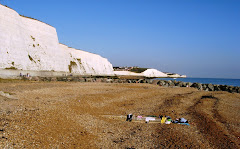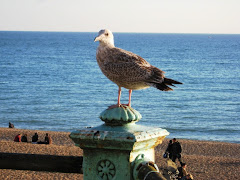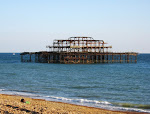
My other half's brother lives in Clevedon, in Somerset, and yesterday we were talking about a place that he'd like to visit close to his home: Steep Holm Island, in the Bristol Channel. So we've agreed top start planning a trip next year.
There's something about islands that stirs the imagination: the sense of escape and isolation; the sense of adventure and achievement in getting there; and something primeval about the sea, sky, and land ahoy!
But there's more to Steep Holm than it just being a small island: It's a nationally important nature reserve, with a colourful history of human occupation. As its name implies, this rocky outcrop of just under 50 acres (20 hectares) has high sea cliffs on all sides, and rises to just over 256ft (78m). Geologically, the island (formed of Carboniferous limestone) is a continuation of the Mendip Hills, lying just off the promontory of Brean Down in Somerset
Steep Holm has been inhabited since Roman times, with evidence of a Viking presence, too. (The name 'holm' is Norse and means 'island'.) In the 12th century, a small priory was established here, and a warren of rabbits was managed until modern times. In the late 1860s, the island was fortified as part of a plan by Prime Minister Palmerston to protect the Bristol Channel against foreign attack: barracks were built and two batteries of 7-ton guns installed (now scheduled ancient monuments). The island was similarly fortified in both subsequent World Wars.
Since 1974, the island has been owned by the Kenneth Allsop Memorial Trust and maintained as a nature reserve: it is a Site of Special Scientific Interest (SSSI) thanks to its unique Mediterranean micro-climate (frosts are rare), relative lack of human disturbance, and because botanical records have been kept for 400 hundred years.
The island is covered with dense thickets of Alexanders (Smyrnium olustratum), home to the only UK colonies of Wild Peony (Paeonia mascula), as well as important colonies of wild leek (Allium ampeloprasum), henbane (Hyoscyamun niger), Caper Spurge (Euphorbia lathyrus). A form of Buck's-horn plantain (Plantago coronupus) is unique to the island. Indeed, the 'Type specimen' (the definitive specimen which describes the species) for the leek plant was taken from the island and is now at the herbarium in Kew Gardens.
As well as the rabbits, there are also colonies of shy Muntjac Deer, as well as several species of gull, and it is a stopping point for many types of migrant birds. Its isolation has meant that many types of animals have diverged from their mainland counterparts and are studied for their genetic traits - especially apparent in the snail populations and those of the Slow Worm, Anguis fragilis.
Although no longer inhabited (except for wildlife wardens for part of the year), it can be visited. The Kenneth Allsop Memorial Trust organises boat trips during the summer months - for which advanced booking (by telephone) is essential. Part of an old barracks is used as an interpretation centre.
There is no landing pier on the island, so visitors must be fit enough (and suitably dressed!) to go ashore by gang-plank, and to ascend the steep paths on the island. Given the Channel's fickle weather, conditions are always changeable, windy and usually cooler than on the mainland. The Channel's strong tides mean that visits normally last about 8-10 hours.
Full details are on the Trust's websites - as above, and at: www.steepholm.freeserve.co.uk/trips.html.





